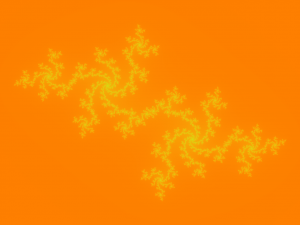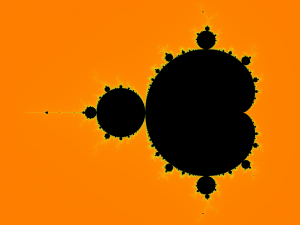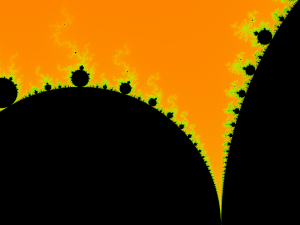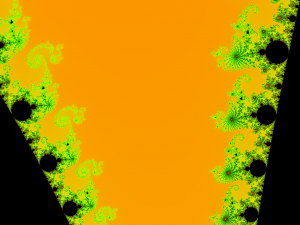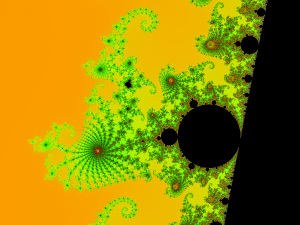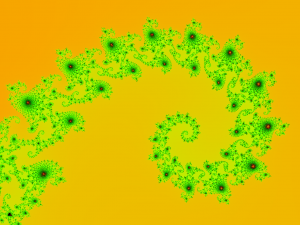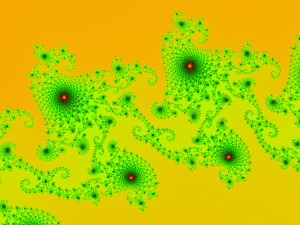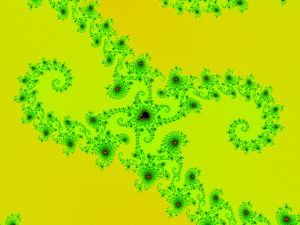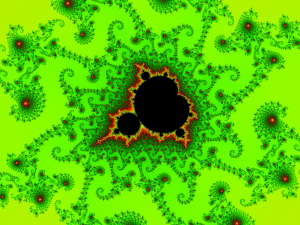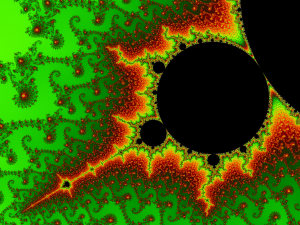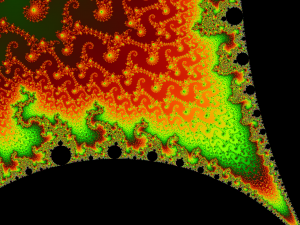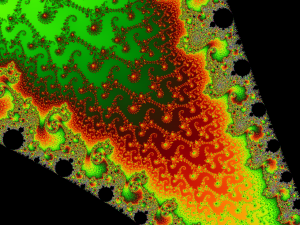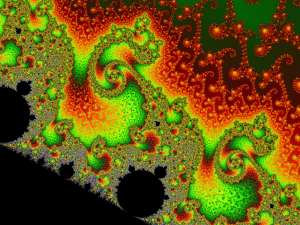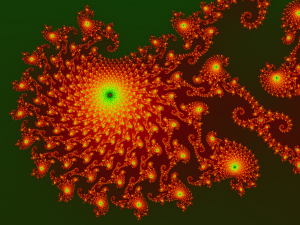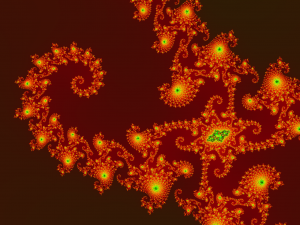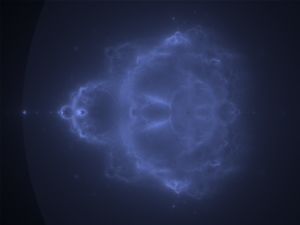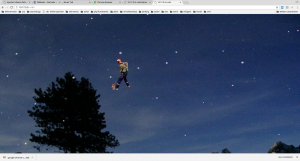Morten, Johannes und Angelo sind da. Der Code wird perfektioniert:
#include <stdio.h>
#include <stdlib.h>
#include <assert.h>
#include <SDL/SDL.h>
typedef struct _Color Color;
struct _Color
{
unsigned char r, g, b;
};
typedef struct _Point Point;
struct _Point
{
int x, y;
};
SDL_Surface *screen;
void
drawPixel(int x, int y, Color c)
{
*((Uint32*)((char*)screen->pixels + x*screen->format->BytesPerPixel + y*screen->pitch)) = SDL_MapRGB(screen->format, c.r, c.g, c.b);
}
void
drawLine(Point p1, Point p2, Color c)
{
int dx, dy;
int incx, incy;
float m;
dx = p2.x - p1.x;
dy = p2.y - p1.y;
incx = dx>0 ? 1 : -1;
incy = dy>0 ? 1 : -1;
if(dx == 0){
int y;
for(y = p1.y; y != p2.y; y += incy)
drawPixel(p1.x, y, c);
return;
}
if(abs(dx)>abs(dy)){
int x;
float y;
m = (float)dy/(float)abs(dx);
y = p1.y;
for(x = p1.x; x != p2.x; x += incx){
drawPixel(x, y+0.5f, c);
y += m;
}
}else{
int y;
float x;
m = (float)dx/(float)abs(dy);
x = p1.x;
for(y = p1.y; y != p2.y; y += incy){
drawPixel(x+0.5f, y, c);
x += m;
}
}
}
void
drawTriWire(Point p1, Point p2, Point p3, Color c)
{
drawLine(p1, p2, c);
drawLine(p2, p3, c);
drawLine(p3, p1, c);
}
void
drawHorizontalLine(int y, float x1f, float x2f, Color c) {
int x1, x2, tmp;
x1 = (x1f == (int)x1f) ? x1f : x1f+1;
x2 = (x2f == (int)x2f) ? x2f : x2f+1;
if(x1 > x2){
tmp = x1;
x1 = x2;
x2 = tmp;
}
while(x1 < x2)
drawPixel(x1++, y, c);
}
void
//~ sortPoints(Point **p) ident mit zeile drunter, for educational purpose only
sortPoints(Point *p[])
{
#define SWAPPOINT(p,q) { \
tmp = p; \
p = q; \
q = tmp; \
}
Point *tmp;
if(p[0]->y > p[1]->y)
SWAPPOINT(p[0], p[1]);
if(p[0]->y > p[2]->y)
SWAPPOINT(p[0], p[2]);
if(p[1]->y > p[2]->y)
SWAPPOINT(p[1], p[2]);
#undef SWAPPOINT
}
void
drawTriFlat(Point p1, Point p2, Point p3, Color c)
{
float dx[3];
int y;
float x1, x2;
Point *p[] = {&p1, &p2, &p3};
sortPoints(p);
#define D(p,q) (q->y - p->y == 0 ? 0.0f : (float) (q->x - p->x) / (q->y - p->y))
//~ dx[0] = (float) (p[2]->x - p[0]->x) / (p[2]->y - p[0]->y);
dx[0] = D(p[0], p[2]);
dx[1] = D(p[0], p[1]);
dx[2] = D(p[1], p[2]);
#undef D
y = p[0]->y;
x1 = x2 = p[0]->x;
while(y < p[1]->y){
drawHorizontalLine(y, x1, x2, c);
y++;
x1 += dx[0];
x2 += dx[1];
}
x2 = p[1]->x;
while(y < p[2]->y){
drawHorizontalLine(y, x1, x2, c);
y++;
x1 += dx[0];
x2 += dx[2];
}
}
void
drawRect(Point p1, Point p2, Color rgb)
{
int i, j;
for(i = p1.x; i < p2.x; i++)
for(j = p1.y; j < p2.y; j++)
drawPixel(i, j, rgb);
}
void
draw(void)
{
drawRect((Point){40,140}, (Point){50,150}, (Color) {255, 0, 255});
drawRect((Point){80,140}, (Point){90,150}, (Color) {255, 0, 255});
drawRect((Point){62,160}, (Point){68,180}, (Color) {10, 123, 233});
drawRect((Point){40,195}, (Point){90,200}, (Color) {123, 233, 10});
// drawLine((Point){0, 0}, (Point){50, 30});
// drawLine((Point){0, 0}, (Point){30, 50});
// drawLine((Point){50, 0}, (Point){50, 50});
drawTriFlat((Point){30,120}, (Point){100, 120}, (Point){65, 100}, (Color){25, 85, 155});
}
int
main(void)
{
int running = 1;
int w = 640;
int h = 480;
SDL_Event event;
SDL_Init(SDL_INIT_VIDEO);
screen = SDL_SetVideoMode(w, h, 32, SDL_HWSURFACE);
while(running){
while(SDL_PollEvent(&event))
if(event.type == SDL_QUIT)
running = 0;
SDL_LockSurface(screen);
draw();
SDL_UnlockSurface(screen);
SDL_UpdateRect(screen, 0, 0, 0, 0);
}
SDL_Quit();
return 0;
}
bringt:

Angelo will keine Kreise machen.
#include
#include
#include
#include <SDL/SDL.h>
#include
typedef struct _Color Color;
struct _Color
{
unsigned char r, g, b;
};
typedef struct _Point Point;
struct _Point
{
int x, y;
};
SDL_Surface *screen;
void
drawPixel(int x, int y, Color c)
{
*((Uint32*)((char*)screen->pixels + x*screen->format->BytesPerPixel + y*screen->pitch)) = SDL_MapRGB(screen->format, c.r, c.g, c.b);
}
void
drawLine(Point p1, Point p2, Color c)
{
int dx, dy;
int incx, incy;
float m;
dx = p2.x - p1.x;
dy = p2.y - p1.y;
incx = dx>0 ? 1 : -1;
incy = dy>0 ? 1 : -1;
if(dx == 0){
int y;
for(y = p1.y; y != p2.y; y += incy)
drawPixel(p1.x, y, c);
return;
}
if(abs(dx)>abs(dy)){
int x;
float y;
m = (float)dy/(float)abs(dx);
y = p1.y;
for(x = p1.x; x != p2.x; x += incx){
drawPixel(x, y+0.5f, c);
y += m;
}
}else{
int y;
float x;
m = (float)dx/(float)abs(dy);
x = p1.x;
for(y = p1.y; y != p2.y; y += incy){
drawPixel(x+0.5f, y, c);
x += m;
}
}
}
void
drawTriWire(Point p1, Point p2, Point p3, Color c)
{
drawLine(p1, p2, c);
drawLine(p2, p3, c);
drawLine(p3, p1, c);
}
void
drawHorizontalLine(int y, float x1f, float x2f, Color c) {
int x1, x2, tmp;
x1 = (x1f == (int)x1f) ? x1f : x1f+1;
x2 = (x2f == (int)x2f) ? x2f : x2f+1;
if(x1 > x2){
tmp = x1;
x1 = x2;
x2 = tmp;
}
while(x1 < x2) drawPixel(x1++, y, c); } void //~ sortPoints(Point **p) ident mit zeile drunter, for educational purpose only sortPoints(Point *p[]) { #define SWAPPOINT(p,q) { \ tmp = p; \ p = q; \ q = tmp; \ } Point *tmp; if(p[0]->y > p[1]->y)
SWAPPOINT(p[0], p[1]);
if(p[0]->y > p[2]->y)
SWAPPOINT(p[0], p[2]);
if(p[1]->y > p[2]->y)
SWAPPOINT(p[1], p[2]);
#undef SWAPPOINT
}
void
drawTriFlat(Point p1, Point p2, Point p3, Color c)
{
float dx[3];
int y;
float x1, x2;
Point *p[] = {&p1, &p2, &p3};
sortPoints(p);
#define D(p,q) (q->y - p->y == 0 ? 0.0f : (float) (q->x - p->x) / (q->y - p->y))
//~ dx[0] = (float) (p[2]->x - p[0]->x) / (p[2]->y - p[0]->y);
dx[0] = D(p[0], p[2]);
dx[1] = D(p[0], p[1]);
dx[2] = D(p[1], p[2]);
#undef D
y = p[0]->y;
x1 = x2 = p[0]->x;
while(y < p[1]->y){
drawHorizontalLine(y, x1, x2, c);
y++;
x1 += dx[0];
x2 += dx[1];
}
x2 = p[1]->x;
while(y < p[2]->y){
drawHorizontalLine(y, x1, x2, c);
y++;
x1 += dx[0];
x2 += dx[2];
}
}
void
drawRect(Point p1, Point p2, Color rgb)
{
int i, j;
for(i = p1.x; i < p2.x; i++)
for(j = p1.y; j < p2.y; j++)
drawPixel(i, j, rgb);
}
void
drawCircle(Point center, int radius, Color c) {
Point p;
int x;
int y;
for(x = 0; x < radius; x++){
y = sqrt(radius*radius - x*x);
drawLine((Point) {center.x + x, center.y + y}, (Point) {center.x + x, center.y - y}, c);
drawLine((Point) {center.x - x, center.y + y}, (Point) {center.x - x, center.y - y}, c);
}
}
void
draw(void)
{
drawCircle((Point){65, 170}, 45, (Color) {128, 128, 0});
drawRect((Point){40,140}, (Point){50,150}, (Color) {255, 0, 255});
drawRect((Point){80,140}, (Point){90,150}, (Color) {255, 0, 255});
drawRect((Point){62,160}, (Point){68,180}, (Color) {10, 123, 233});
drawRect((Point){40,195}, (Point){90,200}, (Color) {123, 233, 10});
// drawLine((Point){0, 0}, (Point){50, 30});
// drawLine((Point){0, 0}, (Point){30, 50});
// drawLine((Point){50, 0}, (Point){50, 50});
drawTriFlat((Point){30,120}, (Point){100, 120}, (Point){65, 100}, (Color){25, 85, 155});
}
int
main(void)
{
int running = 1;
int w = 640;
int h = 480;
SDL_Event event;
SDL_Init(SDL_INIT_VIDEO);
screen = SDL_SetVideoMode(w, h, 32, SDL_HWSURFACE);
while(running){
while(SDL_PollEvent(&event))
if(event.type == SDL_QUIT)
running = 0;
SDL_LockSurface(screen);
draw();
SDL_UnlockSurface(screen);
SDL_UpdateRect(screen, 0, 0, 0, 0);
}
SDL_Quit();
return 0;
}

Nächste Woche ist nicht.
Angelo orientiert sich nach dem GS UsersManual für die PS2.
